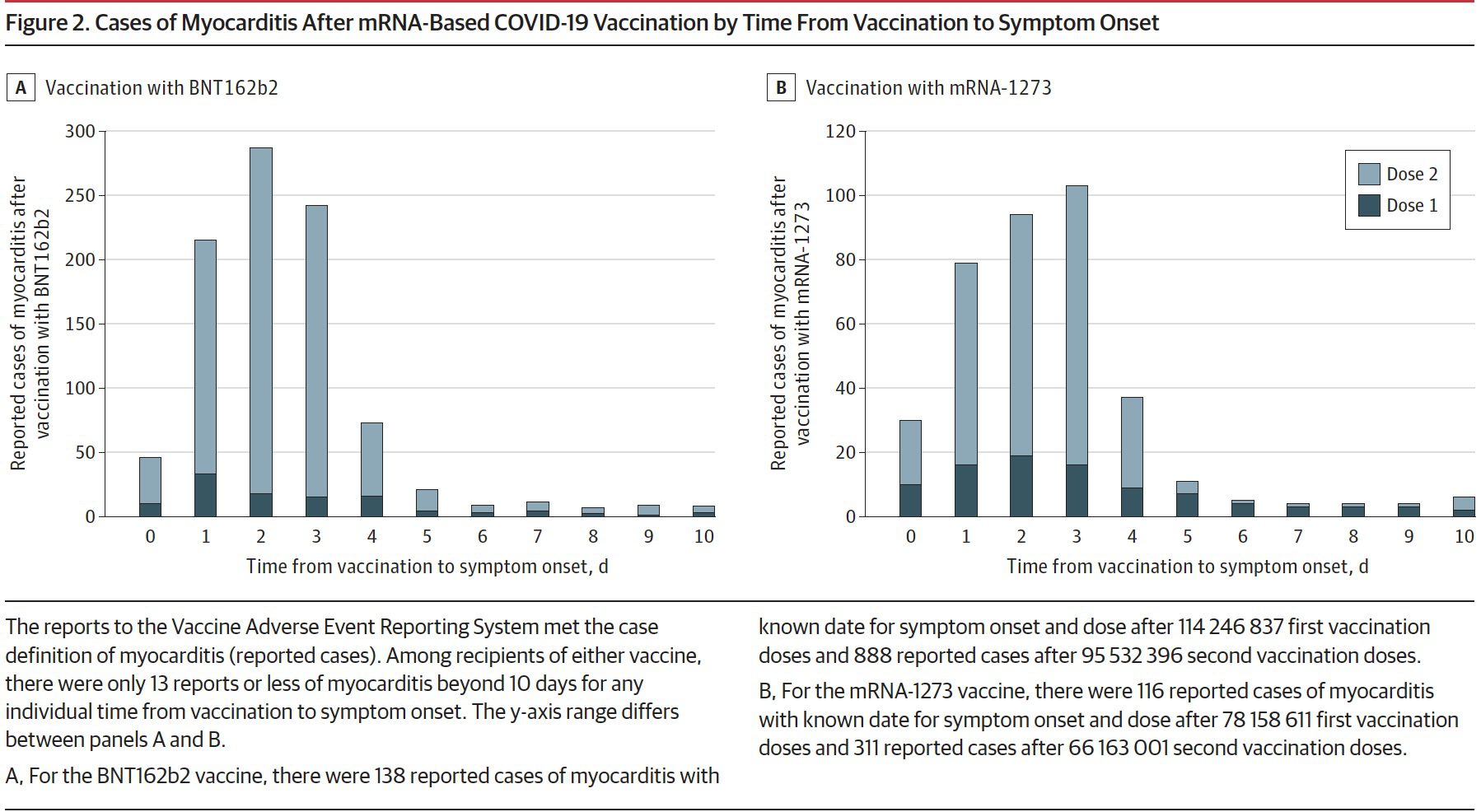Top American Medical Journal Study Confirms the Risk of Myocarditis and Pericarditis After Receiving COVID-19 Vaccines – Risks is Highest After Second Vaccine in Adolescent Males and Young Men
A new study released on Tuesday by the Journal of the American Medical Association (JAMA) revealed the development of myocarditis and pericarditis after mRNA-based COVID-19 vaccination which is highest in adolescent males and young men.
The study was based on the data from VAERS on reported cases of myocarditis that occurred after receiving the Pfizer and Moderna vaccine between December 2020 and August 2021 in 192, 405 ,448 individuals older than 12 years of age in the US. These data were processed by VAERS as of September 30, 2021.
The primary outcome after the vaccination was the occurrence of myocarditis and the secondary outcome was pericarditis.
According to the study, VAERS received 1,991 reports of myocarditis (391 of which also included pericarditis) after receipt of at least 1 dose of mRNA-based COVID-19 vaccine and 684 reports of pericarditis without the presence of myocarditis.
Of the 1991 reports of myocarditis, 1,626 met the CDC’s case definition for probable or confirmed myocarditis. (See table below)

From Journal of the American Medical Association:
Findings In this descriptive study of 1,626 cases of myocarditis in a national passive reporting system, the crude reporting rates within 7 days after vaccination exceeded the expected rates across multiple age and sex strata.

The rates of myocarditis cases were highest after the second vaccination dose in adolescent males aged 12 to 15 years (70.7 per million doses of the BNT162b2 vaccine), in adolescent males aged 16 to 17 years (105.9 per million doses of the BNT162b2 vaccine), and in young men aged 18 to 24 years (52.4 and 56.3 per million doses of the BNT162b2 vaccine and the mRNA-1273 vaccine, respectively).
Meaning Based on passive surveillance reporting in the US, the risk of myocarditis after receiving mRNA-based COVID-19 vaccines was increased across multiple age and sex strata and was highest after the second vaccination dose in adolescent males and young men.
Main Outcomes and Measures Reports of myocarditis to VAERS were adjudicated and summarized for all age groups. Crude reporting rates were calculated across age and sex strata. Expected rates of myocarditis by age and sex were calculated using 2017-2019 claims data. For persons younger than 30 years of age, medical record reviews and clinician interviews were conducted to describe the clinical presentation, diagnostic test results, treatment, and early outcomes.
Results Among 192, 405,448 persons receiving a total of 354,100,845 mRNA-based COVID-19 vaccines during the study period, there were 1,991 reports of myocarditis to VAERS, and 1,626 of these reports met the case definition of myocarditis. Of those with myocarditis, the median age was 21 years (IQR, 16-31 years) and the median time to symptom onset was 2 days (IQR, 1-3 days).
Males comprised 82% of the myocarditis cases for whom sex was reported. The crude reporting rates for cases of myocarditis within 7 days after COVID-19 vaccination exceeded the expected rates of myocarditis across multiple age and sex strata. (See graph below)
The rates of myocarditis were highest after the second vaccination dose in adolescent males aged 12 to 15 years (70.7 per million doses of the BNT162b2 vaccine), in adolescent males aged 16 to 17 years (105.9 per million doses of the BNT162b2 vaccine), and in young men aged 18 to 24 years (52.4 and 56.3 per million doses of the BNT162b2 vaccine and the mRNA-1273 vaccine, respectively). There were 826 cases of myocarditis among those younger than 30 years of age who had detailed clinical information available; of these cases, 792 of 809 (98%) had elevated troponin levels, 569 of 794 (72%) had abnormal electrocardiogram results, and 223 of 312 (72%) had abnormal cardiac magnetic resonance imaging results. Approximately 96% of persons (784/813) were hospitalized and 87% (577/661) of these had resolution of presenting symptoms by hospital discharge. The most common treatment was nonsteroidal anti-inflammatory drugs (589/676; 87%).

Conclusions and Relevance Based on passive surveillance reporting in the US, the risk of myocarditis after receiving mRNA-based COVID-19 vaccines was increased across multiple age and sex strata and was highest after the second vaccination dose in adolescent males and young men. This risk should be considered in the context of the benefits of COVID-19 vaccination.
Read the full study here:
Myocarditis Cases Reported After mRNA-Based COVID-19 Vaccination in the US From December 2020 to August 202… by Jim Hoft on Scribd

No comments